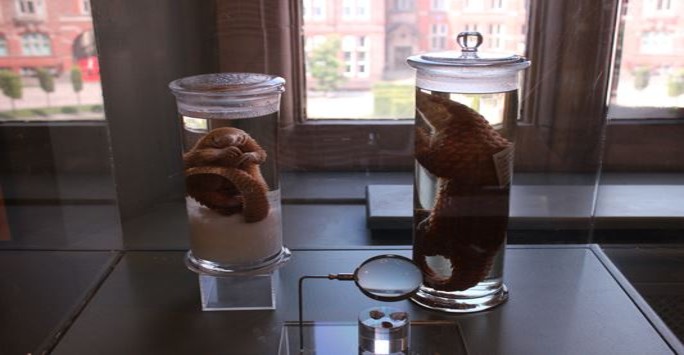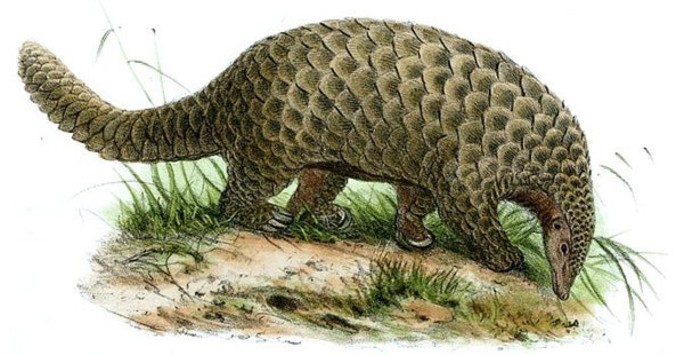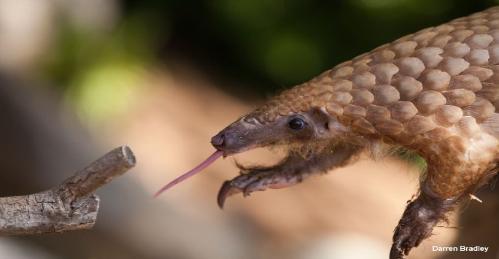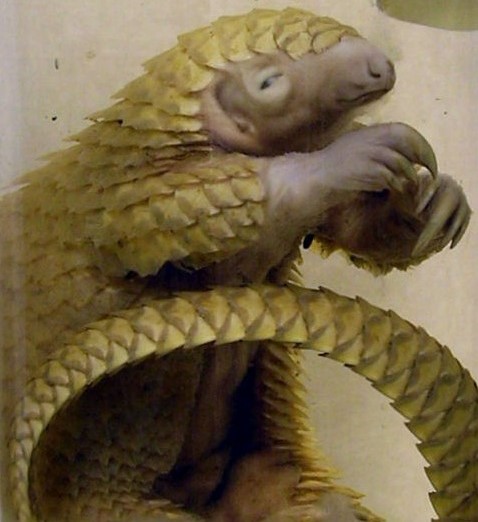Pangolin The Worlds Most Illegally Trafficked Mammal
Posted on: 5 June 2020 by Lorna Sergeant Collections and Exhibitions Officer in 2020

When you visit the Tate Hall museum you will see many jars with amazing creatures suspended within. Look closer and you will see something rather special. These two historical Pangolin specimens from the late 19th century University Zoology Departmental museum. Today is World Environment Day, this year’s theme is “to celebrate biodiversity”. There are nearly 1 million species on our planet facing extinction, one of which is the seriously endangered pangolin who is essential to the biodiversity of our planet.
These very shy specialised nocturnal mammals are seriously under threat, they may become extinct within the next decade.

Illustration of an African Giant pangolin Smutsia gigantea, by John Wolf. Image in public domain
So, what is a pangolin?
There are no other mammals on earth like the pangolin species. Pangolins (or scaly anteaters) are mammals which live in Africa and Asia. There are 8 species of pangolin 4 Asian and 4 African. They are incredibly unique, making their own Order (a scientific group of species). Until recently, their nearest relatives were unknown, with some scientists believing it was the anteaters and sloths. In fact, pangolins are most closely related to the carnivores. They have scales on their skin making them look a little like a pine cone or a globe artichoke. They are the only mammals which have this adaptation. Pangolin scales are made of keratin, just like our finger nails, and are attached to muscles under the skin.

Pangolin poised to eat its prey. Image courtesy of Darren Bradley
Ecosystem Engineers "if we diminish the natural world we diminish ourselves"- David Attenborough
These shy creatures are extremely important to the complex ecosystems in our world. Our health as humans depends on very complex ecosystems that are a consequence of tens of millions of years of evolution. If the balance is upset by an animal such as the pangolin being wiped out of the system completely, it can cause humans problems. Pangolins are termed by scientists as a key stone species. Pangolins are highly specialised insectivores (insect-eater) they consume ants and termites. They hunt at night, using their senses of smell and hearing (they have poor eyesight) to locate their prey. Pangolins use their strong front claws to tear the nest open and gather the insects into its mouth using its long tongue (which is as long as its body!) coated in sticky saliva. Pangolins can consume up to 20,000 ants a day. That’s about 73 million ants a year. In consuming such large quatities they regulate ants and termites reducing damage to forests, crops and homes. Additionally they areate the soil by digging which allows plants to grow. If pangolins were to be extinct we don’t know what the knock-on effect would be but we could soon be overrun by termites and ants, potential mass crop failure and deforestation as they protect forests from termite destruction.
Why are they trafficked and traded?
The pangolin's main predators are wild cats, hyenas and above all else humans. Human hunting is currently the most significant threat to the pangolin. Pangolin comes from ‘penggulung,’ the Malay word for roller – the action a pangolin takes in self-defence. However, this form of protection is also it’s downfall as they can be easily picked up by poachers and put into a sack. The pangolin is traded illegally and then consumed by locals as bush meat, their meat and scales are exported to asian countries as eating the meat is seen as a status symbol. Pangolin scales are also very lucrative and are sold to be used for cultural purposes and in traditional medicine. All eight species of pangolin are classified as threatened with extinction. Scientists estimate 400,000 are hunted each year in central Africa alone. This illegal wildlife trade has many negative consequences for biodiversity and human’s wellbeing too. It creates a narrower genetic pool and therefore less resilience to resist diseases and viruses of any kind.
In 2016, pangolins were afforded the highest level of protection by the Convention on International Trade in Endangered Species (CITES). The protective order bans the practice of selling pangolins but multiple investigations have revealed they are still traded illegally. Where there is demand there is trade and trafficking regardless of the consequences.
How can we help save this species?
It all starts with awareness. Encourage friends and family to understand threats to this species. Support the conservation efforts by wildlife groups to combat the illegal trafficking. Don’t eat pangolin meat or buy pangolin products.

Future generations may think these fabulous creatures are merely relics in a museum but sadly historic museum specimens like ours may be the only pangolins left for future generations to see.
Keywords: Pangolin, Extinct, CITES - Convention on International Trade in Endangered Species of Wild Fauna and Flora, Museum.